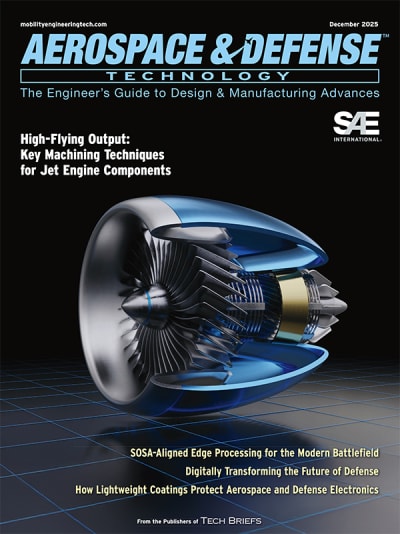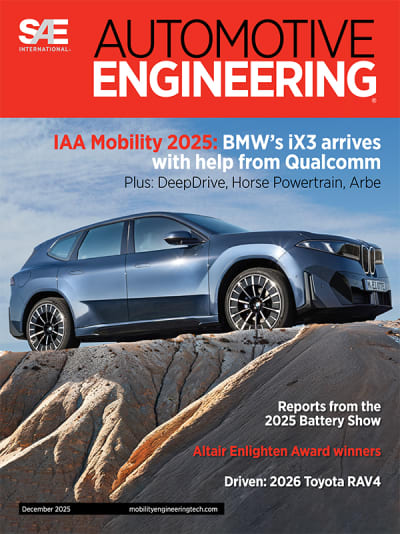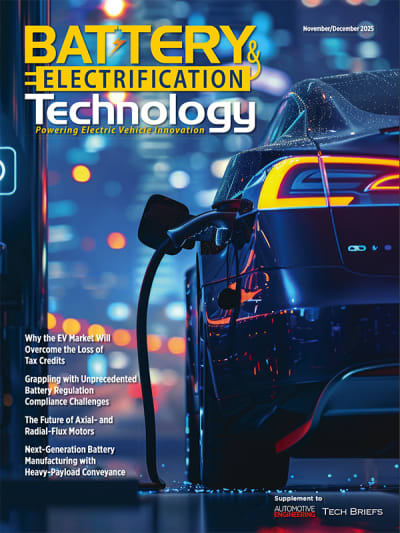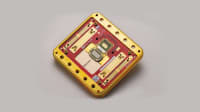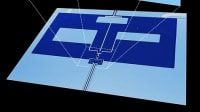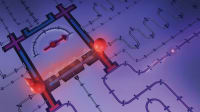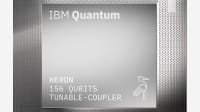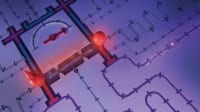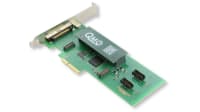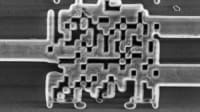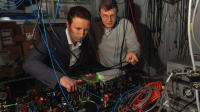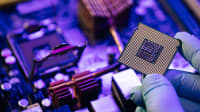Researchers Achieve Breakthrough in New Design of Superconducting Quantum Processor

Researchers at the University of Chicago Pritzker School of Molecular Engineering have realized a new design for a superconducting quantum processor — aiming at a potential architecture for the large-scale, durable devices the quantum revolution demands.
Unlike the typical quantum chip design that lays the information-processing qubits onto a 2-D grid, the team from the Cleland Lab has designed a modular quantum processor comprising a reconfigurable router as a central hub.
This enables any two qubits to connect and entangle, whereas in the older system, qubits can only talk to the qubits physically nearest to them.
“Imagine you have a classical computer that has a motherboard integrating lots of different components, like your CPU or GPU, memory and other elements,” said Ph.D. student Xuntao Wu. “Part of our goal is to transfer this concept to the quantum realm.”
Wu is the first author of a new paper published in Physical Review X that describes this new way of connecting superconducting qubits. The researchers’ new quantum chip is flexible, scalable and as modular as the chips in cellphones and laptops.
Size and Noise
Quantum computers are highly advanced yet delicate devices with the potential to transform fields such as telecommunications, healthcare, clean energy, and cryptography. But two things must happen before quantum computers can tackle these global problems to their fullest potential.

First, they must be scaled to large enough size with flexible operability. “This scaling can offer solutions to computational problems that a classical computer simply cannot hope to solve, like factoring huge numbers and thereby cracking encryption codes,” Prof. Andrew Cleland said.
Second, they must be able to perform massive calculations with few errors, ideally surpassing the processing power of current state-of-the-art classical computers.
The superconducting qubit platform is one promising approach to building a quantum computer. But the designs used so far need rethinking.
“A typical superconducting processor chip is a square shape with all the quantum bits fabricated on that. It’s a solid-state system on a planar structure,” said study co-author Haoxiong Yan, who graduated from PME in the spring and now works as a quantum engineer for Applied Materials.
This typical design causes several limitations.
First, putting qubits on a grid means each qubit can only interact with, at most, four other qubits – its immediate neighbors to the north, south, east and west. Connecting more qubits would make a more powerful processor, but until the PME team, researchers hadn’t found a practical path around the “nearest neighbor” limit.
Also, if all qubits are fabricated on the same planar substrate, this poses a significant challenge to the fabrication process, as even a small number of failed devices means the processor won’t work.
“To undertake practical quantum computing, we need millions or even billions of qubits and we need to make everything perfectly,” Yan said.
Rethinking the Chip
To work around these issues, the team retouched the design of the quantum processor.
Taking inspiration from classical computers, the design clusters qubits around a central router, similar to how PCs talk to each other through a central network hub.
The researchers’ new quantum chip is flexible, scalable and as modular as the chips in cellphones and laptops. Quantum “switches” can connect and disconnect any qubit within a few nanoseconds, enabling high-fidelity quantum gates and the generation of quantum entanglement, a fundamental resource for quantum computing and communication.
The processor is designed to be modular, so that different components can be pre-selected before being mounted onto the processor motherboard.
“In principle there's no limit to the number of qubits that can connect via the routers,” said Wu. “You can connect more qubits if you want more processing power, as long as they fit in a certain footprint.”
The team’s next steps are working on ways to scale up the quantum processor to more qubits, find novel protocols for expanding the processor’s capabilities, and, potentially, find ways to link router-connected qubit clusters the way supercomputers link their component processors.
They’re also looking to expand the distance over which they can entangle qubits.
“Right now, the coupling range is sort of medium-range, on the order of millimeters,” Wu said. “So if we're trying to think of ways to connect remote qubits, then we must explore new ways to integrate other kind of technologies with our current setup.”
The research for this breakthrough was funded by the Army Research Office and Laboratory for Physical Sciences, Air Force Office of Scientific Research.
Top Stories
INSIDERLighting Technology
![]() Using Ultrabright X-Rays to Test Materials for Ultrafast Aircraft
Using Ultrabright X-Rays to Test Materials for Ultrafast Aircraft
INSIDERManufacturing & Prototyping
![]() New 3D-Printable Nanocomposite Prevents Overheating in Military Electronics
New 3D-Printable Nanocomposite Prevents Overheating in Military Electronics
INSIDERDefense
![]() F-22 Pilot Controls Drone With Tablet
F-22 Pilot Controls Drone With Tablet
Technology ReportAR/AI
![]() Talking SDVs and Zonal Architecture with TE Connectivity
Talking SDVs and Zonal Architecture with TE Connectivity
INSIDERManufacturing & Prototyping
![]() New Defense Department Program Seeks 300,000 Drones From Industry by 2027
New Defense Department Program Seeks 300,000 Drones From Industry by 2027
INSIDERAerospace
![]() Anduril Completes First Semi-Autonomous Flight of CCA Prototype
Anduril Completes First Semi-Autonomous Flight of CCA Prototype
Webcasts
Test & Measurement
![]() SAE Automotive Engineering Podcast: Additive Manufacturing
SAE Automotive Engineering Podcast: Additive Manufacturing
Information Technology
![]() A New Approach to Manufacturing Machine Connectivity for the Air Force
A New Approach to Manufacturing Machine Connectivity for the Air Force
Automotive
![]() Optimizing Production Processes with the Virtual Twin
Optimizing Production Processes with the Virtual Twin
Power
![]() EV and Battery Thermal Management Strategies
EV and Battery Thermal Management Strategies
Manufacturing & Prototyping
![]() How Packet Digital Is Scaling Domestic Drone Battery Manufacturing
How Packet Digital Is Scaling Domestic Drone Battery Manufacturing
Automotive
![]() Advancements in Zinc Die Casting Technology & Alloys for Next-Generation...
Advancements in Zinc Die Casting Technology & Alloys for Next-Generation...

